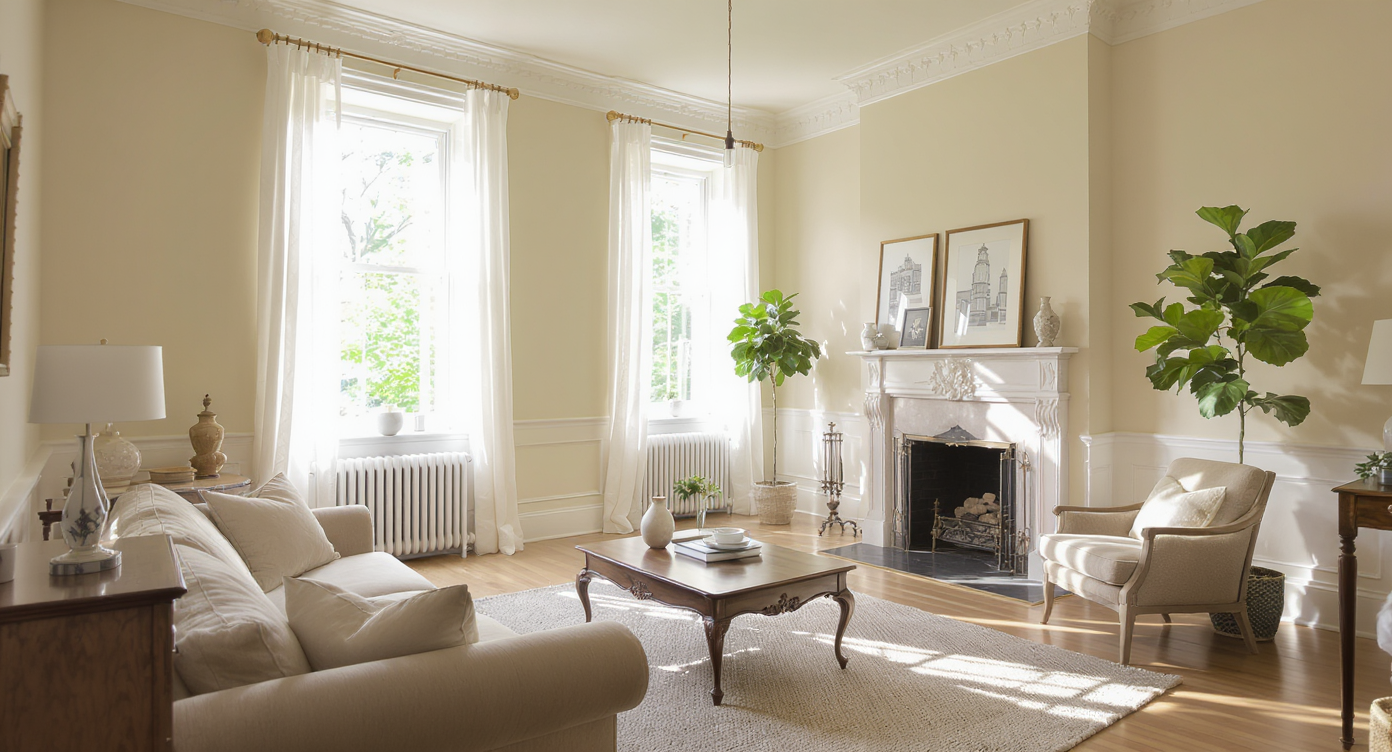TL;DR
Short answer: yes, you can confidently buy a century home without a fireplace. Many early-1900s houses skipped fireplaces in favor of modern radiators and coal furnaces. If you crave the glow, the best fireplace alternatives for old homes include direct‑vent gas units, high-efficiency wood or pellet stoves, and realistic electric inserts, all of which can fit period style with the right surround and mantel.
The fireplace dilemma in old houses

Classic cast-iron radiators provide efficient, period-appropriate warmth in century homes without fireplaces.
Here’s the thing: a missing fireplace in a 1900–1920 house isn’t a red flag. In many regions, it was a selling point. Steam and hot‑water radiators were the cutting‑edge technology of the 1880s onward, and by 1910 plenty of “modern” homes were designed without fireplaces at all. In other words, the absence of a hearth can signal innovation, not compromise.
I’ve toured countless century homes where owners assumed a covered chimney or blocked-off hearth meant something had been lost. Often, nothing was. These houses heated beautifully via basement coal furnaces and radiators, with cleaner walls, fewer drafts, and more usable wall space. If charm is what you want, you can add it—without inheriting a century of chimney problems.
How to decide—and what to install if you want a fireplace
A missing fireplace is not a deal-breaker in a century home; treat it as an aesthetic choice plus a mechanical project with clear costs and codes.
- Clarify your goal first. Do you want ambiance, real heat, or off‑grid resilience? Define this and your “fireplace” choice becomes obvious.
- Direct‑vent gas fireplace (no masonry chimney required). Typical installed cost: $2,500–$7,000. Many deliver 20,000–35,000 BTU with 70–85% efficiency and sealed combustion, which improves indoor air quality and avoids backdrafts. Great for zone heating a living room.
- Gas insert into an existing coal/wood opening. Expect $3,000–$10,000 including liner and safety upgrades. Experts recommend a camera inspection of the flue before any insert work.
- Electric insert or freestanding electric “stove.” From $200–$1,200, plug‑in, 1,500‑watt heaters (~5,000 BTU) with surprisingly believable flame effects. No venting, minimal maintenance, ideal for allergy-sensitive households.
- High‑efficiency wood stove or wood‑burning insert. Installed costs often run $3,000–$6,000; a stainless liner can add $1,500–$4,000. Many models can heat most of a floor plan. Rule of thumb: maintain clearances per manufacturer and local code; hearth extensions are typically 16 inches in front and 8 inches to each side of the opening.
- Pellet stove. $2,000–$4,000 plus venting; hopper-fed convenience and strong heat output. Note that some municipalities restrict pellets and new wood-burning appliances, so verify local rules first.
- Codes, climate, and air quality. Many cities now limit new wood-burning fireplaces; some allow only certified stoves. Install carbon monoxide and smoke detectors on each floor and near sleeping areas.
- Budget for maintenance. Annual chimney sweeping typically costs $150–$350; relining $2,000–$5,000; chimney rebuilds can reach $8,000–$15,000. Chimney caps often run $300–$700; flashing repairs $1,000–$2,500. Insurance may be lower without a working fireplace.
- Aesthetics without the headache. Salvaged mantels ($150–$1,000) and period tile can create a stunning focal point around a gas or electric unit. For the holidays, stockings look classic on a stair banister or built-in bookcase.
User insight: Many owners who swore they were “fireplace people” discovered they used a direct‑vent gas unit daily while ignoring a hard-to-start wood hearth. Convenience wins.
Anecdote
A family in a 1912 house had three shallow coal fireplaces—none safe for wood. A $3,200 direct‑vent gas insert transformed one room into a daily-use, switch-on cozy zone. They later framed a salvaged mantel around an electric insert in the study for symmetry and stockings, keeping costs and maintenance low.
Common mistakes to avoid
Don’t assume a fireplace equals value; in old houses it can just as easily mean ongoing costs, drafts, and code constraints.
- Assuming no fireplace means the house was “lesser.” Designers often note that radiator-heated homes around 1910 were considered premium and more efficient than open hearths.
- Underestimating retrofit costs. It’s common for old coal fireplaces to be too shallow for wood; converting safely can require a gas insert and liner. Get line-item quotes before you fall in love with a mantel.
- Ignoring energy loss. An open wood-burning fireplace can function as a giant exhaust, pulling warm air up the flue. Glass doors, dampers, or sealed inserts reduce heat loss dramatically.
- Forgetting local restrictions. Some cities discourage or prohibit new wood fireplaces and allow only certified stoves or gas. Always check building and air quality codes first.
- Letting layout suffer. A forced focal point can hinder furniture placement. Sometimes the best living room layout happens without a chimney breast at all.
Pro tips from designers and builders
Treat the hearth like any other mechanical upgrade: inspect, model the heat load, then choose the cleanest, code-compliant path.
- Start with a camera inspection. Before any insert or liner, a chimney camera reveals hidden voids, failed mortar, or offsets. It’s the fastest way to avoid surprises.
- Prefer sealed combustion. Direct‑vent gas and certified wood/pellet stoves reduce indoor pollutants, drafts, and negative pressure issues compared with open fireplaces.
- Design the surround with history in mind. Reclaimed mantels, quarter-sawn oak, and period tile patterns keep the living room authentic, even around an electric insert.
- Use zone heating to your advantage. Keep the main thermostat 2–3 degrees lower in winter and run a 20k–30k BTU gas unit in rooms you occupy most for comfort and savings.
- Plan clearances early. Many wood stoves need 12–36 inches of clearance to combustibles or approved heat shields; verify clearances, hearth size, and mantel height before you order.
- Reflection: The coziest rooms I’ve covered weren’t defined by an open fire; they were defined by lighting, texture, and places to gather. The flame was a bonus.
Helpful tools, sources, and image ideas
Use the right tools and sources to get period style with modern performance.
- Visual planning: Mock up a mantel, tile surround, or built‑in with ReimagineHome to test fireplace alternatives in your exact room.
- Architectural salvage: Look for antique mantels, cast-iron summer covers, and vintage tile at local reuse centers for authentic character.
- Pros to hire: Certified chimney sweep, licensed HVAC or gasfitter, and a contractor familiar with NFPA 211 and local codes.
- Suggested image captions and alt text:
- Alt: “Direct‑vent gas fireplace in a 1910 living room with oak mantel and art tile.”
- Alt: “Electric insert tucked into a salvaged Victorian mantel, stockings on stair banister.”
- Alt: “Compact cast‑iron wood stove with tile hearth in an American Foursquare.”
Visualization Scenario
Picture a tall-ceilinged 1910 living room. You center a reclaimed oak mantel on the longest wall, set a slim direct‑vent gas firebox inside, and finish with moss-green art tile. A wool rug, two reading lamps, and a petite bookcase flank the opening. The flame glows at the touch of a button, and the room warms fast—no chimney rebuild, no smoke—just the look and comfort you wanted.
FAQ: quick answers for searchers
Should I buy a house without a fireplace?
Yes. Many century homes were built without fireplaces because radiators and coal furnaces were considered premium, efficient heating for the era.
How much does it cost to add a gas fireplace to an old house?
A direct‑vent gas fireplace typically costs $2,500–$7,000 installed; a gas insert into an existing opening often runs $3,000–$10,000 with liner work.
What are the best fireplace alternatives for old homes?
Top options include direct‑vent gas units, certified wood or pellet stoves, and realistic electric inserts paired with a salvaged mantel for period style.
Are wood-burning fireplaces bad for indoor air quality?
Open wood fireplaces can increase particulates and drafts; sealed stoves and direct‑vent gas units reduce indoor pollutants and heat loss.
How do I hang Christmas stockings without a fireplace?
Use a stair banister, built‑in shelves, or a salvaged mantel on a blank wall; all give a classic look without a working hearth.
What really makes a historic house feel like home
The soul of a century home isn’t the chimney; it’s good bones, light, scale, and thoughtful upgrades that respect the architecture. If a fireplace was part of your dream, you have options—from sealed gas to whisper-quiet electric—without inheriting a failing flue. And if you choose to keep the walls clean and the layout flexible, you’ll join a long tradition of “modern for their time” homeowners who did the same.
Ready to see what a mantel, stove, or built‑ins could look like in your rooms? Test ideas in minutes with ReimagineHome and land on a design that feels right for your house and your life.




.svg)

.svg)



.png)